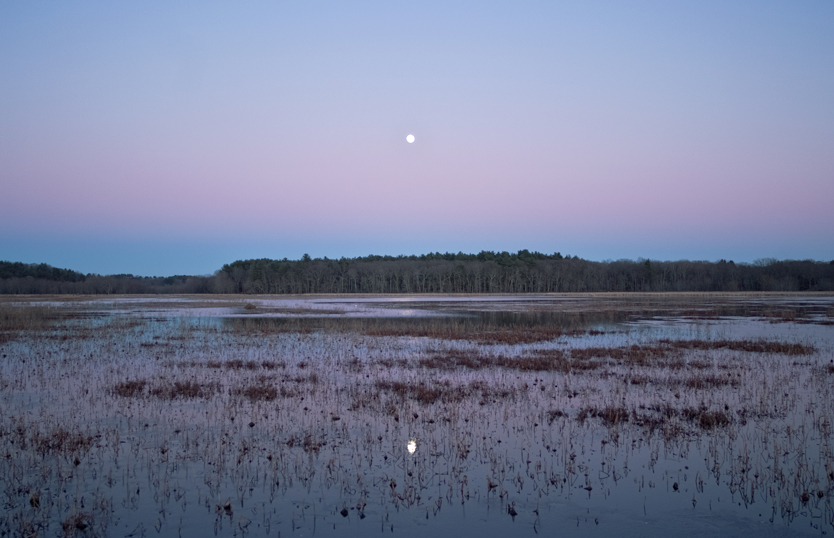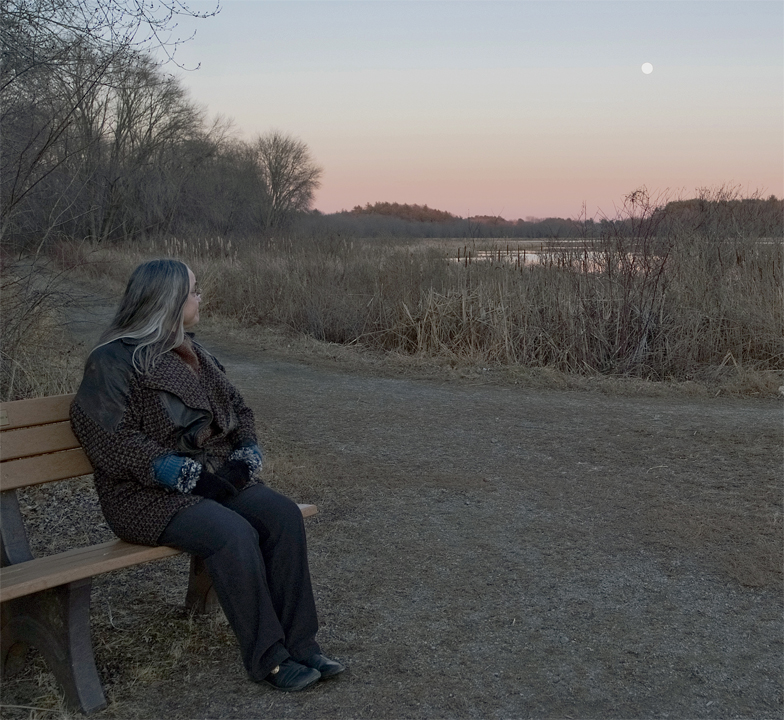Halcyon Day
Life will pull you under if you let it and grind you to fine dust. I decided to steal a moment away from the usual cares while the mild weather lasted. Yesterday, Mr. Snacho and I went walking through The Great Meadows marsh in Concord at sunset – which was also moonrise, as the moon was one day before full. The sky and the water held rainbow colors; the land was infinite shades of brown and gray, deep in hibernation.
We’ve gone to that marsh in all seasons and it has never ceased to be wondrous, despite its obvious domestication. Once we chanced upon an enormous ebony and golden fuzzy caterpillar hurrying on its way to more food that would let it become a moth. We’ve seen all kinds of birds, from chickadees to hawks, as well as the occasional terrapin. I keep hoping that one day we’ll catch a glimpse of the elusive river otters, or the beavers from the lodge that peeks through the reeds.
This time, in the glass-calm water I detected a wake of two nostrils that eventually resolved into a muskrat busily fluffing its pelt. In the middle distance we spied three swans alongside the duck and goose flotillas. And we saw something incredibly beautiful across the sky, the contrast heightened by the bare branches. It coincidentally appeared in NASA’s picture of the day, so I discovered its lay name: the Belt of Venus.
Normally, the earth’s shadow below the reflected reddened sunlight is darker than the sky above. But yesterday, for some reason the shadow was a lovely shade of teal. While it lasted, it felt like we walked inside a shimmering opal pendant.
Whenever I see such beauty, I float on it and dream: what marvels like this will we see if we ever walk under strange skies?
My moon, faraway and alone,
sleepless and tireless, you hung on the balcony.
Come, my shipmistress, come to my window.
— from an old popular Hellenic song
Photos of Great Meadows: Peter Cassidy




How very, very beautiful, Athena. Lovely meditation and beautiful photos by Peter.
Yes, sometimes we have to stop and just look…
That is indeed very beautiful, and the photos Peter took are wonderful.
I’m very happy you like it! It has been a tiring last half year — non-stop grant writing and the tenure paperwork ordeal… it’s easy to forget that we are surrounded by beauty.
Oh the new photo! Not only is the sky every bit as beautiful as you describe, but the reflected moon in the marsh is like a bright pearl!
Isn’t it otherworldly? And yet so much of this world! *happy sigh*
If you click on the image, you can see a larger version in which the details stand out.
So very beautiful. Nowadays so many people forget to stop and just look at the sky. There are just so many things to see- infinite variations of cloud shape and color, the Moon, Venus, Mars, Jupiter, the Milky Way (when under dark skies), and even the International Space Station (when you know when to look!!).
Speaking of alien skies- the sun an alien world orbits might be larger or smaller, a different color, or even have a companion or two. Perhaps there will be a different moon, or more moons, or maybe a ring of debris around the planet (that might be bad for any civilizations on the surface…). If one lands on a habitable moon orbiting a gas giant, the parent world will be an imposing sight in the moon’s sky.
On the other hand, anyone who landed on a planet that was forever covered by a thick layer of clouds- like early SF writers though Venus might be like- will never the sun, nor any moons, nor the stars. Nothing but a flat sheet of clouds, perhaps even an endless rainstorm if the settlers are really unlucky.
I’ve always wondered, though, whether life on such a planet would really be feasible. How do the Venusian plants photosynthesize in Ray Bradbury’s The Long Rain if the sun is perpetually blocked out by the Venusian cloud cover? Perhaps they don’t. Mushrooms, after all, don’t need light. Maybe an underground source of nutrients fed an upside-down ecosystem based on rot and decay. The astronauts who died did decompose fairly quickly…
I remember a few good examples of exotic alien skies from James Blish’s A Life for the Stars. There was a planet with perpetual cloud cover where the human settlers lived in fortresses and used specially designed vehicles to cross the sea of endless mud that surrounded their homes. Another planet was located inside a star cluster. At night the sky was ablaze with hundreds of dazzling red and blue stars blazing brighter than Venus or Jupiter.
That’s not even counting the bizarre sights space explorers will see (or have seen) in our own solar system- the Earth rising over the Moon’s horizon, Phobos and Deimos suspended in the pinkish Martian sky, the brilliant glare of light reflecting of Venus’s cloud layers, Jupiter’s multicolored cloud bands and whirling storm systems, Saturn rising over one of her icy companion moons, or Charon hanging over Pluto’s chilly surface. There isn’t any lack of strange skies in our solar system and beyond.
Beyond individual works of space art (many of which can be seen at Novaspace), there is a book that shows a lot of such hypothetical skies: Cycles of Fire, by Bill Hartmann and Ron Miller. Also, there are several SF stories that play beautifully with such questions: for example, Joan Vinge’s terrific Eyes of Amber, in which an intelligent race lives on Titan; most of the time the cloud cover is total, but on rare occasions one catches a momentary glimpse of The Wheel of Change — Saturn.
I always loved space art- especially the conceptual kind that tries to imagine what life on alien worlds or future spacecraft might look like. I’ll check out Cycles of Fire sometime.
It’s quite interesting to imagine what effect the sky a species can see has upon their culture. If an intelligent species can’t see through their own atmosphere easily, they might never see the stars- which would have a profound effect on their culture and science. If early humans had never been able to see the stars, their conception of the universe around them would have been drastically changed. Imagine- no astronomy, no crystal spheres or worlds floating in a cosmic ocean on a turtle with sparks of firing rotating above, and so on.
If there was hardly ever a break in the haze surrounding an intelligent alien species home planet, perhaps they would spend centuries wondering what lay beyond that cloud cover. Once someone invented a flying machine- probably some form of balloon- it would take a brave pilot to finally ascend through the haze and break beyond it to find that there was a sky above the clouds.
I’ve read that an alien planet near a nebula would see a sky full of ghostly green tendrils- narrow shocked filaments that run all through some nebula. I’d always assumed that the bright streaks that some SF films fill the background behind spacecraft with were totally unrealistic, but it seems that you might see this in some parts of the cosmos. Fact is indeed stranger than fiction…
I think even for urban dwellers it’s refreshing to rediscover and enjoy the bits of nature that survive in the corners we grant it. San Diego is spread over several mesas (not as sharp as in New Mexico and Arizona but still similar) and there are hiking trails in the canyons between. Over the past few months we’ve taken to Saturday morning walks. We’ve spotted rabbits, raptors, and even a couple of coyotes who were commuting to their daytime hiding places. It helps of course that San Diego is temperate all year round.
Several animals and plants adapt well to living in the periphery of urban areas. Coyotes and foxes are perfect examples; so are raptors, who feast on squirrels and pigeons. Coming back home late, I’ve bumped into opossums, racoons, skunks, peregrine falcons. This is Cambridge we’re talking about (though the clean-up of the Charles River has contributed mightily to the comebacks of flora and fauna). I’ve had hummingbirds, chickadees and cardinals come to my flower boxes and a robin built her nest on a beam of my porch. Then there are the persistent legends about mountain lions in the Quabbin Reservoir… (smile)
I live in Arizona, and I frequently encounter javelina, bobcats, rabbits, hummingbirds, quail, bluejays, doves, snakes, etc. when I go outside. I had to surround my garden patch with a three-foot high metal mesh fence to keep the javelina from decimating the plants. Fluffy coyotes hang around occasionally. Speaking of skunks- I don’t see them, but sometimes they are spraying other animals nonstop around my house.
It’s kind of nice to have all the animals come to me instead of having to go see the animals- I doubt I’d see more animals on a hike than I see in my backyard.
When I used to live in the Boston area I visited that pond all the time! In some of my last visits there we took our oldest son for walks by carrying him on my back. If I did that now I would be in the hospital. :^)
Even though the place is human-made, it was always quite refreshing to be there. I bet even Concord resident and legend Henry David Thoreau would have liked it.
I once saw a snapping turtle eating what was left of a fish on the water’s edge among many other natural sights.
Thanks for helping to bring back those pleasant memories, Athena.
I’m glad it brought back memories, Larry! As you say, it’s human-made but critters came to it and brought it to life.
I am also glad to see that the place is still there. I mean I would have been surprised if they did bulldoze it or something like that to make way for some condos, but in this current era one never knows.
They got rid of the Big Ear radio telescope at Ohio State University in 1998 because the college knew it could make a lot more money off some condos and a golf course over the longest-running SETI program in history (this was the place where the Wow! signal was detected in 1977).
Even more surprising, the powers-that-be are getting rid of the Women’s Center in Ithaca, NY because the place is not making money to make way for an apartment complex. They are going to put their resources online, but I don’t think that can replace an actual, physical place for women to go to for information and help, even if online is cheaper. The building is about 50 years old and in need of repair, too.
Plus, what happens to those women who do not have or cannot afford a computer and Internet connection? Yeah, they can go to the local library, if they don’t mind getting a whole half-hour on an antiquated PC after waiting in line for the service. This much I can relate from personal experience.